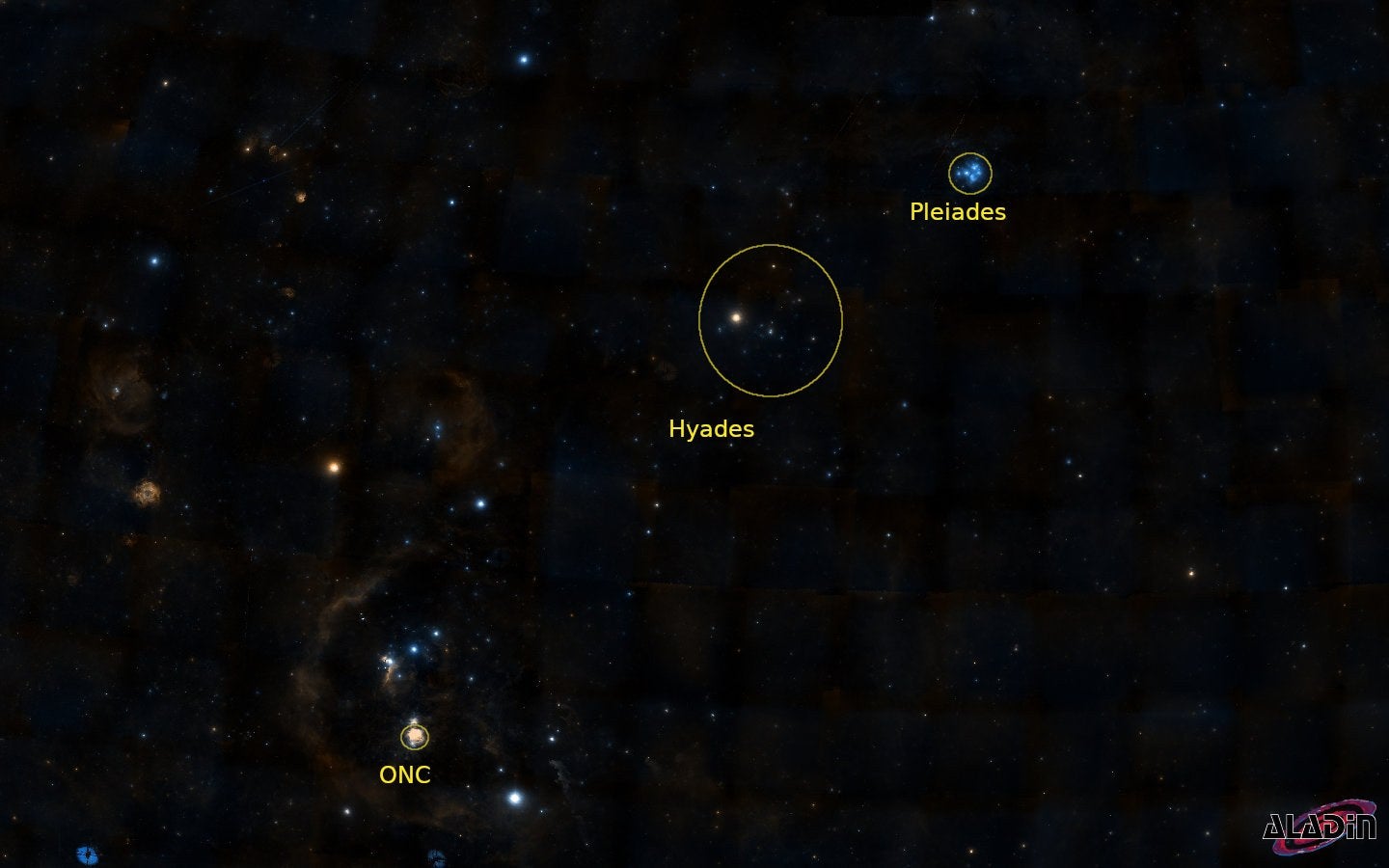Recent research has revealed that three well-known star clusters — the Orion Nebula Cluster, the Pleiades, and the Hyades — are linked in a cosmic family tree. Though these clusters appear distinct today, advanced simulations now suggest they represent different stages in the life of a single, evolving star system. The Orion Nebula shows the early, dense beginnings. The Pleiades reflect a middle-age cluster, and the Hyades offer a glimpse of its older, more dispersed form.
Astrophysicists at the Institute for Advanced Studies in Basic Sciences in Zanjan, Iran, and the University of Bonn modeled this evolution using high-precision direct N-body simulations. Their work, published in the Monthly Notices of the Royal Astronomical Society, confirms what was long suspected: these clusters didn’t just form near each other in space — they likely evolved from the same initial group of stars.
The Orion Nebula Cluster, located about 1,350 light-years away and only 2.5 million years old, contains roughly 4,000 stars packed into a compact, gas-rich region. Over time, clusters like this lose mass as powerful stellar winds, UV radiation, and supernova explosions push away the leftover gas. This process causes the cluster to expand rapidly.
From Cradle to Dispersal
As stars form in these compact clouds, energy from massive stars begins to eject the gas that helped create them. This early gas expulsion, happening within the first 10 million years, causes a dramatic shift. Clusters like Orion become “supervirial,” meaning they hold too much kinetic energy to stay tightly bound. As a result, they start to expand.
Computer models show that by 100 million years — the current age of the Pleiades — the cluster loses about 53% of its stars but retains a stable core. Eventually, after roughly 700 million years, what remains resembles the Hyades cluster: a loose group of older stars with only 9% of the original members left.
These long-term simulations, powered by the advanced nbody6 code, help researchers track how star clusters change under the influence of internal dynamics and external forces, such as the pull from the Milky Way’s tidal field. Dr. Ghasem Safaei and Prof. Hosein Haghi led the project, starting from dense, gas-rich initial states and evolving the system over 800 million years.
Related Stories
Their findings matched observed traits such as size, mass, core radius, and star count at each phase. The results support the idea that a single ONC-like cluster could become the Pleiades and later the Hyades through natural aging.
Snapshots Across Cosmic Time
The ONC, Pleiades, and Hyades can be thought of as three snapshots in a stellar lifetime. Professor Pavel Kroupa of the University of Bonn explained it this way: “The Orion Nebula, Pleiades, and Hyades are like three different photos of the same person — as a baby, adolescent, and elderly.”
All three clusters lie close together in the sky. The Orion Nebula sits near Orion’s Sword. The Pleiades, also known as the Seven Sisters, appear as a small, bright grouping of stars. The Hyades form a V-shape in the constellation Taurus. Their proximity has long intrigued astronomers.
Despite their differences in size, age, and structure, these clusters likely originated from the same formation process. The findings suggest that star clusters don’t form randomly but follow a preferred path, shaped by the physical conditions of their birth clouds.
Dr. Kroupa and his team believe that such clusters are born from dense clumps in molecular clouds. These clumps produce stars in compact regions, often influenced by high rates of star formation, energy feedback, and gravity. As gas disperses, the remaining stars settle into a looser arrangement and slowly drift apart.
Testing Star Formation Models
To understand this better, scientists looked at two leading theories for how star clusters form. The first is hierarchical assembly, where small groups of stars merge over time to form larger clusters. The second is monolithic collapse, where a dense region in a molecular cloud rapidly forms a large cluster in one event.
Simulations by Banerjee and Kroupa in 2015 showed that the hierarchical model doesn’t work for clusters like NGC 3603 or R136. These clusters form too quickly and with too much structure for smaller groups to have time to merge. Instead, the monolithic model fits better, suggesting clusters form in one burst and then rapidly evolve as gas is lost.
Further studies by researchers like Zonoozi and Marks found that mass segregation — the way heavier stars settle toward the center — also shapes the fate of a cluster. Clusters with more massive stars at birth tend to dissolve faster and grow larger over time.
By applying these findings to ONC-like clusters, simulations showed that systems with an initial half-mass radius of 0.2–0.3 parsecs and 1200–2000 solar masses best match real-world data. When these clusters include lots of binary stars and strong mass segregation, they evolve just like the Pleiades and Hyades.
Looking Deeper into the Sky
This research also highlights how well computer models can match real-world observations. Combining detailed simulations with telescope data, scientists can now reconstruct the life story of star clusters from their formation to their slow dispersal.
Prof. Akram Hasani Zonoozi, a co-author of the study, explained: “This research gives us a deeper understanding of how star clusters form and develop and illustrates the delicate balance between internal dynamics and external forces such as the gravitational pull of the Milky Way.”
As star clusters like the ONC expand and lose stars, their shapes and brightness change. Over hundreds of millions of years, the transformation is striking. Yet their shared origin gives a clearer picture of how the galaxy shapes its stars.
This work doesn’t just solve a mystery about three well-known clusters. It also helps refine models of how stars and galaxies evolve. These findings may even lead to better predictions about the life cycles of other star groups we observe throughout the universe.
